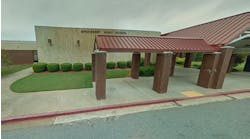Completely securing a campus environment against every threat is impossible; however, just because someone can break a side window doesn't mean you don't lock your front door. Campuses throughout the nation are deploying security technology at an unprecedented pace as an important component of their security programs.
Modern security systems on campus require special attention to ensure that the equipment and systems function as intended, that they do not overburden staff and that they are maximized to their intended benefits. Individual technologies also must integrate seamlessly so that the whole is greater than the sum of its parts.
Straight talk
To help get maximum benefit from security systems, education institutions should review five common mistakes in campus security technology deployment, as well as tips for how to avoid them.
Straight talk
-
Mistake 1: Believing what you read and hear
The security industry does not oversee or regulate what manufacturers print or say about their products. Finding unbiased information about products is difficult. Trying to learn a company's strategic vision for its products and a particular product line is harder. Forecasting which companies may purchase, absorb and otherwise eliminate products is impossible. The flood of proprietary specialty products amplifies the problems faced by decisionmakers.
Schools are challenged for time and resources, and usually need to make decisions quickly. How do education institutions address this challenge? First, they should be skeptical of everything they read and hear. Focus less on technical data such as pixel counts and laboratory-controlled error rates, and more on head-to-head evaluations in real-world conditions. Seek unbiased and experienced evaluations and advice. Use associations or other peer networks to solicit feedback on what works and what doesn't. Before committing to any technology, conduct "proof of concept" testing at a facility to replicate how proposed technologies will perform and, more important, whether the technology meets real needs. This is different from "beta" testing, which allows a company to use a school as a guinea pig for its product development.
Finally, leave an "out" if a particular technology falls flat. Depending on the technologies deployed, putting all security eggs in one basket may not be necessary. Anticipate and prepare for the worst-case scenario. Explore the ways, even with proprietary systems, to lessen the impacts should a change in course be necessary. Develop an infrastructure that can support multiple options.
-
Mistake 2: Thinking technology will solve security problems
Every security technology is only as good as the operational and physical security program that supports it. History has demonstrated time and again that the simplest procedural breakdowns can render useless the most sophisticated systems. Remember, security technology is only one aspect of a security program and depends on the success of the other parts in order to be effective.
Some technology proponents and suppliers might assert that video surveillance cameras can replace the need for campus personnel when, depending on the situation, more personnel ultimately might be needed to receive, assess and respond to alerts generated by advanced systems. It is important to keep expectations reasonable about technology's role in an overall security program and thoroughly understand exactly what the impacts will be from each proposed system. Ultimately, a security program's success may hinge on the perception of how effectively and appropriately security technologies have been deployed on campus.
-
Mistake 3: Insufficient planning
Security incidents on campus are stressful for everyone. Our instincts tell us that the sooner a problem is addressed, the better we will feel. Security technology such as cameras, access control and intrusion detection can seem like obviously good tools to deploy. However, rushing into deployments without appropriate planning is not always best and, in some cases, can create unnecessary liability.
A thorough understanding of the real vs. perceived needs for security technology throughout campus is necessary prior to deploying any equipment. Security planning for a campus involves understanding not only the school's needs and which technologies are appropriate, but also the "low-tech" and "no-tech" supporting features essential to program success. Wherever cameras are deployed, the campus lighting plan should support them. When facilities are designed or renovated, minimum-security technology standards should be in place. Before product standards decisions are made, a thorough evaluation should be performed, including identifying a pool of competent, factory-certified installing companies to provide options and ongoing support. When security systems costs are estimated, anticipate the 5- to 10-year service and maintenance needs in addition to the ongoing personnel and operational costs of maintaining these systems.
-
Mistake 4: Leaving out critical stakeholders
Like many businesses, campuses can be political environments with competing interests, agendas and legacy attitudes. Some administrators have developed a mindset over time that in order to obtain consensus on issues, the pool of stakeholders must be as small as possible. Security projects that proceed without involvement from important stakeholders invite criticism and open the process up to obstacles that can be avoided.
Some of the commonly overlooked stakeholders include service and maintenance staff that will have to maintain systems; field personnel that respond to system alarms; operators that will be using the equipment on a regular basis; and information-technology personnel whose network may be supporting the systems, and may be called on to perform initial troubleshooting and software updates. Other departments that may need to be included are legal, local law enforcement, human resources and procurement. Not every stakeholder needs to be integral to every security technology decision process; however, inviting these stakeholders to the table from the outset can smooth the process and remove much of the potential opposition to a security technology plan.
-
Mistake 5: Deploying more technology than necessary
Just because it can be done doesn't mean it should be done. In recent years, security mandates and grant funding opportunities have enabled campuses to acquire significant amounts of security equipment. Unfortunately, funding processes rewarded those who could provide the best justification for their requests. The nature of this process meant that requests for funds to create a security plan or update company-wide security policies and procedures were given less weight than requests for "bleeding edge" technologies. As a result, whether incident-driven or not, many facilities have deployed more technology than they need. On top of this, too many clients accept "beta" test systems to cheaply augment their existing security systems.
Ultimately, shortsighted technology deployments like these have become impediments. How much technology is enough? Match every technology deployment to a specific documented need. Make sure that these needs cannot be addressed by simpler and easier-to-manage "low-tech" or "no-tech" solutions. One test to evaluate whether a school has deployed too much technology is to perform the following test. Find the person within the organization who is most familiar with the security systems. Ask that person to explain to a selected group of non-security employees (representing various skill and authority levels), what the security systems do and how using this technology benefits the campus. If the explanations are not clear, concise and incorporate every aspect of the systems, the school may have too much equipment.
Black, CPP, PSP, CSC, CET, is senior security consultant and operations manager for TRC in its Irvine, Calif., office. He can be reached at [email protected].



